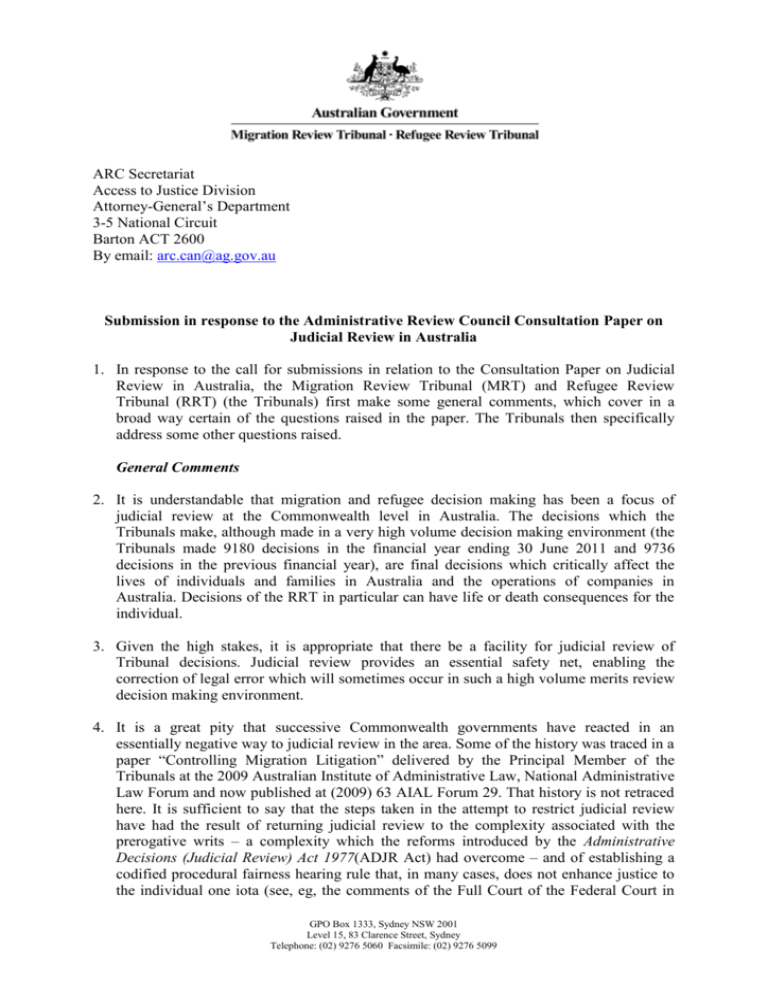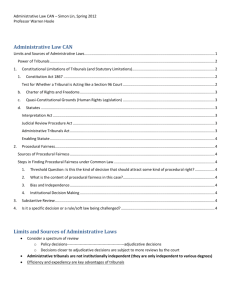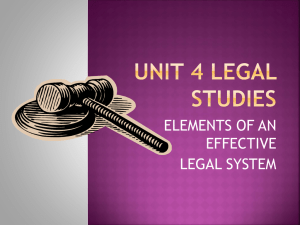submission to ARC inquiry on judicial review
advertisement

ARC Secretariat Access to Justice Division Attorney-General’s Department 3-5 National Circuit Barton ACT 2600 By email: arc.can@ag.gov.au Submission in response to the Administrative Review Council Consultation Paper on Judicial Review in Australia 1. In response to the call for submissions in relation to the Consultation Paper on Judicial Review in Australia, the Migration Review Tribunal (MRT) and Refugee Review Tribunal (RRT) (the Tribunals) first make some general comments, which cover in a broad way certain of the questions raised in the paper. The Tribunals then specifically address some other questions raised. General Comments 2. It is understandable that migration and refugee decision making has been a focus of judicial review at the Commonwealth level in Australia. The decisions which the Tribunals make, although made in a very high volume decision making environment (the Tribunals made 9180 decisions in the financial year ending 30 June 2011 and 9736 decisions in the previous financial year), are final decisions which critically affect the lives of individuals and families in Australia and the operations of companies in Australia. Decisions of the RRT in particular can have life or death consequences for the individual. 3. Given the high stakes, it is appropriate that there be a facility for judicial review of Tribunal decisions. Judicial review provides an essential safety net, enabling the correction of legal error which will sometimes occur in such a high volume merits review decision making environment. 4. It is a great pity that successive Commonwealth governments have reacted in an essentially negative way to judicial review in the area. Some of the history was traced in a paper “Controlling Migration Litigation” delivered by the Principal Member of the Tribunals at the 2009 Australian Institute of Administrative Law, National Administrative Law Forum and now published at (2009) 63 AIAL Forum 29. That history is not retraced here. It is sufficient to say that the steps taken in the attempt to restrict judicial review have had the result of returning judicial review to the complexity associated with the prerogative writs – a complexity which the reforms introduced by the Administrative Decisions (Judicial Review) Act 1977(ADJR Act) had overcome – and of establishing a codified procedural fairness hearing rule that, in many cases, does not enhance justice to the individual one iota (see, eg, the comments of the Full Court of the Federal Court in GPO Box 1333, Sydney NSW 2001 Level 15, 83 Clarence Street, Sydney Telephone: (02) 9276 5060 Facsimile: (02) 9276 5099 SZEEU v MIAC (2006) 150 FCR 214) and instead opens up its own opportunities for litigation. 5. In a recent submission to the Immigration Minister concerning the code the Tribunals noted that approximately 45% of matters remitted by the courts to the RRT for redetermination since the High Court’s decision in SAAP v MIMA (2005) 228 CLR 294 have identified s.424A of the Migration Act 1958 (Migration Act) as the principal ground of contention. It might be argued that a proportion of these matters might have been remitted to the RRT for breach of procedural fairness even if s.424A did not apply. So much may be conceded. However, it is unlikely that the proportion would come even close to the numbers represented by the 45% figure referred to above, especially given that courts not infrequently comment that the particular action taken by the Tribunal would have satisfied common law procedural fairness requirements but did not meet the particular statutory requirement of the code and therefore involved jurisdictional error (see, eg, Le v MIAC [2010] FMCA 460 at [12]). 6. Despite the flawed judicial review architecture to which the Tribunals have referred above, there has been a marked drop in judicial review activity in recent years in relation to Tribunal decisions - see the relevant statistics for the RRT for the past five years set out in the attachment to this submission. Improved decision making at the primary and merits review levels has contributed to this decline. The courts too have played their part to ensure that judicial review is not used merely as a delay tactic. The experience of the Tribunals in recent years is that applications for judicial review of Tribunal decisions are determined promptly by the courts. 7. In the Tribunals’ view, the time is right for the procedural code relating to the putting of adverse information to the applicant to be abolished, for the privative clause to be repealed and for migration and refugee decision making to be brought back under the umbrella of the ADJR Act. Responses to Specific Questions in Paper Q12. What are the advantages and disadvantages of different approaches to the grounds of judicial review – common law or codification of grounds and/or general principles? Which approach is to be preferred and why? What grounds should be included in a codified list? 8. The Migration Act has incorporated a number of differing judicial review regimes since the early 1990s, including the codification of grounds of judicial review. These grounds were substantially similar to those in the ADJR Act, save for the specific exclusion of the grounds of breach of natural justice and unreasonableness. The codified grounds were subsequently removed from the Act. 9. As mentioned above, the Tribunals favour having their decisions brought back within the ambit of the ADJR Act. The Tribunals therefore favour their decisions being subject to the codified grounds of review set out in that Act. While codification of grounds of review cannot achieve certainty, it has the distinct educative benefit of informing potential applicants of the basis upon which judicial review may be sought and of informing decision makers such as the Tribunals of the basis upon which their decisions may be reviewed. 10. While the Tribunals support judicial review under a scheme where the grounds of review are codified, the Tribunals are not averse to consideration being given to the adoption of a different model of codification, or the addition of additional grounds as discussed in paragraph 4.82 of the Consultation Paper. Q13. What is the role, if any, for statutory codes of procedure, given that they may not provide certainty about what will amount to procedural fairness in a particular case? 11. As mentioned above, the Migration Act sets out “codes of procedures” which apply to reviews by the Tribunals1 and which are taken to be ‘an exhaustive statement of the natural justice hearing rule in relation to the matters [they deal] with’. 2 The experience in the migration jurisdiction has been that codification aimed at supplanting the natural justice hearing rule has distinct limitations. Although the codification of procedure may have the advantage of setting out a framework for the parties, experience shows that it leads to unexpected interpretation, uncertainty and extensive litigation. A procedural code may be interpreted not to exclude the operation of common law procedural fairness unless it does so expressly3 and even then may be subject to restrictive interpretation.4 The amount of litigation surrounding the procedural codes in the migration context demonstrates that codification far from ensures certainty and the Tribunals’ experience is that the codes do not necessarily guarantee procedural fairness. Statutory codes of procedure, whilst providing a framework for the parties, cannot replicate the adaptiveness of common law procedural fairness. Q16. One of the objectives of this examination of judicial review is to identify all examples of legislation or subordinate legislation that include a specific right to reasons. Are there examples of provisions giving a right to reasons which provide useful illustrations of effective content, timing and form of reasons? 12. The Migration Act provides that both Tribunals must prepare a written statement of reasons for decision5 which must be notified to the applicant.6 This requirement is broadly similar to that in s.13 of the ADJR Act and s.43 of the Administrative Appeals Tribunal Act 1975. Under the Migration Act, the written statement of reasons must be provided to the applicant within 14 days of the date on which the decision is made7 and must: (a) set out the decision of the Tribunal on the review; and (b) set out the reasons for the decision; and (c) set out the findings on any material questions of fact; and (d) refer to the evidence or any other material on which the findings of fact were based.8 1 See Part 5 Division 5 and Part 7 Division 4 of the Migration Act. Sections 357A(1) and 422B(1) of the Migration Act. 3 In Re MIMA; Ex parte Miah (2001) 206 CLR 57, prior to the insertion of ss.357A(1) and 422B(1) which excluded the operation of the natural justice hearing rule, a majority of the High Court found that the procedural code in the Migration Act did not exclude the decision-maker’s obligation to accord procedural fairness to an applicant. 4 See, for example, Saeed v MIAC (2010) 241 CLR 252 where the Court found that the exclusion of procedural fairness by s.51A of the Migration Act was to be considered having regard to the text of s.51A itself - in particular, the words “in relation to the matters it deals with” - and the provisions interacting with it. The Court found in that instance that the common law rules of procedural fairness did not operate in respect of s.57 [provision of adverse information] but only to the extent of the specific “matters” it dealt with - that is the provision of adverse information to persons in the migration zone, not other persons such as offshore applicants. 5 Sections 368(1) and 430(1) of the Migration Act. 6 Sections 368A(1) and 368D and 430A(1) and 430D of the Migration Act. 7 Sections 368A(1) and 368D and 430A(1) and 430D of the Migration Act. 8 Sections 368(1) and 430(1) of the Migration Act. 2 13. The Tribunals’ obligation to record their reasons in this way serves to promote public confidence in the integrity of the administrative process, ensure that the Tribunals’ reasoning process is disclosed so that an unsuccessful applicant understands why he or she failed, have a normative effect on primary decision making and provide a written record of the decision in the event of judicial review.9 Q19. What other consequences, if any, should there be for a failure to provide adequate reasons, particularly if there was a general obligation to provide reasons? 14. The Tribunals consider that it is not necessary to impose further consequences for failure to provide reasons. The reasons for a decision serve to demonstrate that a statutory power has been lawfully exercised and thus it is in agencies’ interests to set them out. As has been shown in the migration context, while a failure to provide adequate reasons may of itself be unlikely to be regarded as a jurisdictional error,10 the failure may reveal a jurisdictional error in the decision making process.11 The imposition of additional consequences for the failure to provide adequate reasons may have the effect of creating another level of litigation focusing on the form of reasons rather than the substance of the decision.12 15. If the Council has any questions in relation to the matters raised in this submission, it should contact Sobet Haddad, the Tribunals’ Director of Legal Services, in the first instance on (02) 9276 5112 or at sobet.haddad@mrt-rrt.gov.au . Denis O’Brien Principal Member 5 July 2011 9 MIMA v Eshetu (1999) 197 CLR 611; Mr A v MIMA [1999] FCA 1086; Xu v MIMA (1999) 95 FCR 425; MIMA v Yusuf (2001) 206 CLR 323. 10 See Re MIMA; Ex parte Durairajasingham [2000] HCA 1; Xu v MIMA (1999) 95 FCR 425 and MIAC v SZLSP (2010) 187 FCR 362. 11 MIMA v Yusuf (2001) 206 CLR 323. 12 See MIMA v Eshetu (1999) 197 CLR 611. Attachment - Judicial Review of RRT Decisions13 13 Actual numbers of decisions set aside as at 1 July 2011 are: 2010/11 – 19; 2009/10 – 44; 2008/09 – 119; 2007/08 – 169; 2006/07 –242. Some applications for judicial review remain outstanding and as such the number of set aside decisions is volatile. The number of unresolved applications for judicial review as at 1 July 2011 are: 2010/11 – 229; 2009/10 – 29; 2008/09 – 4; 2007/08 – 0; 2006/07 – 4.







